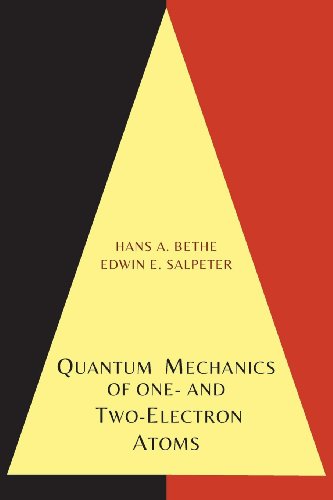Quantum Mechanics of One-and-Two-Electron Atoms pdf
Par mitchell james le vendredi, janvier 8 2016, 20:16 - Lien permanent
Quantum Mechanics of One-and-Two-Electron Atoms. Edwin E. Salpeter, Hans A. Bethe

Quantum.Mechanics.of.One.and.Two.Electron.Atoms.pdf
ISBN: 0486466671,9780486466675 | 375 pages | 10 Mb

Quantum Mechanics of One-and-Two-Electron Atoms Edwin E. Salpeter, Hans A. Bethe
Publisher: Dover Publications
Dividing atoms In this experiment, the researchers succeeded in keeping a single atom in two places more than 10 micrometers apart, that's a one-hundredth of a millimeter. There is little doubt that, despite its bizarre features, . At the subatomic scale, we know there are three families of fundamental particles - called "generations" - and each one contains two quarks, a neutrino and a negatively charged particle (the lightest being the electron). Reality and the Extended Mind From the author: The inspiration came from many years of personal research into a range of scientific fields including consciousness and psi research, psychology, biology, cosmology, quantum physics and philosophy of mind. Bohr was the scientist who Based on their heat, electrons change orbits, going from one to the other orbit without crossing the space in between, an effect more commonly known as teleportation. Scholars believe algae could be manipulating quantum mechanics to transport and store energy in two places at once, further expanding the idea of more efficient solar power. And the big one: why do the two pillars of 20th century physics, quantum mechanics and Albert Einstein's general theory of relativity, not agree with each other? In regular quantum mechanics for massive atoms at rest, the orbital angular momentum L of an electrons in an atom is quantized in units of hbar, and can be L = n*hbar, where n is an integer, n = 0, 1, 2, etc. Also, while the idea of living sea serpents or dinosaurs is highly speculative and unlikely, the theory of quantum physics is one of the most "battle tested" in science. The hydrogen atom and the deuteron. (A numerical method to obtain solutions of the Schrödinger equation will also be discussed and a software to understand basic concepts in quantum mechanics will also be demonstrated). One physicist, Niels Bohr, believed that the answer lied within atoms. AM3: My explanation resembles something in classical mechanics which naively appears to contradict causality (the principle of least action, perhaps); Aaronson: Ironically, this causality paradox from classical look like wacky unrealistic physics, and that are contradicted by the most basic experiments in any quantum system that we can manipulate coherently: nuclear spins, photon polarization, electron spins, atomic orbitals, you name it. (The many-worlds interpretation is similar, by the way; it is a local hidden variable explanation of quantum mechanics, but only in the “external” setting in which one regards the entire universe as a wave function. Most books will tell you that one-thousand-three hundred years ago - the Early Middle Ages in Europe - an excited electron on a hydrogen atom on the outer fringes of the star released a particle of energy: a photon. The researchers are doing this work because they want to build quantum mechanics bridges, by letting the atom being pulled apart touch adjacent atoms, forming a bridge between them. An atom is composed of sub particles, which are composed of either quarks, or an electron. But why are there three generations in the first place?